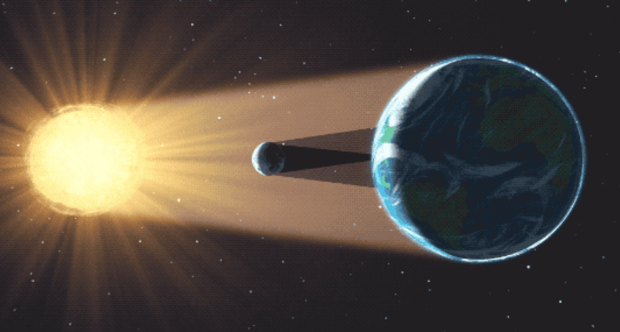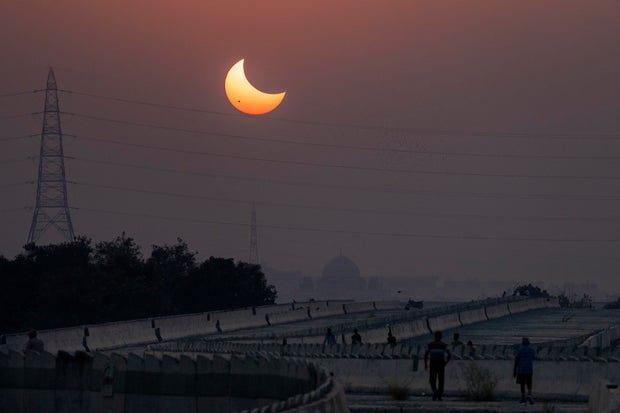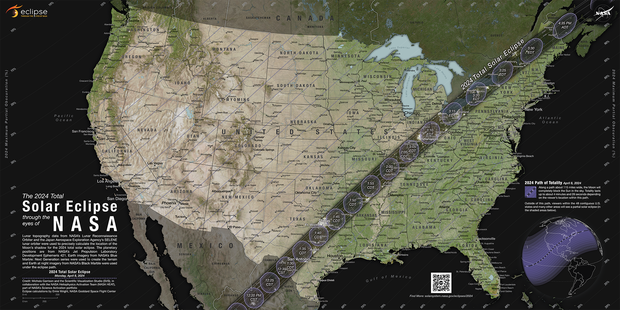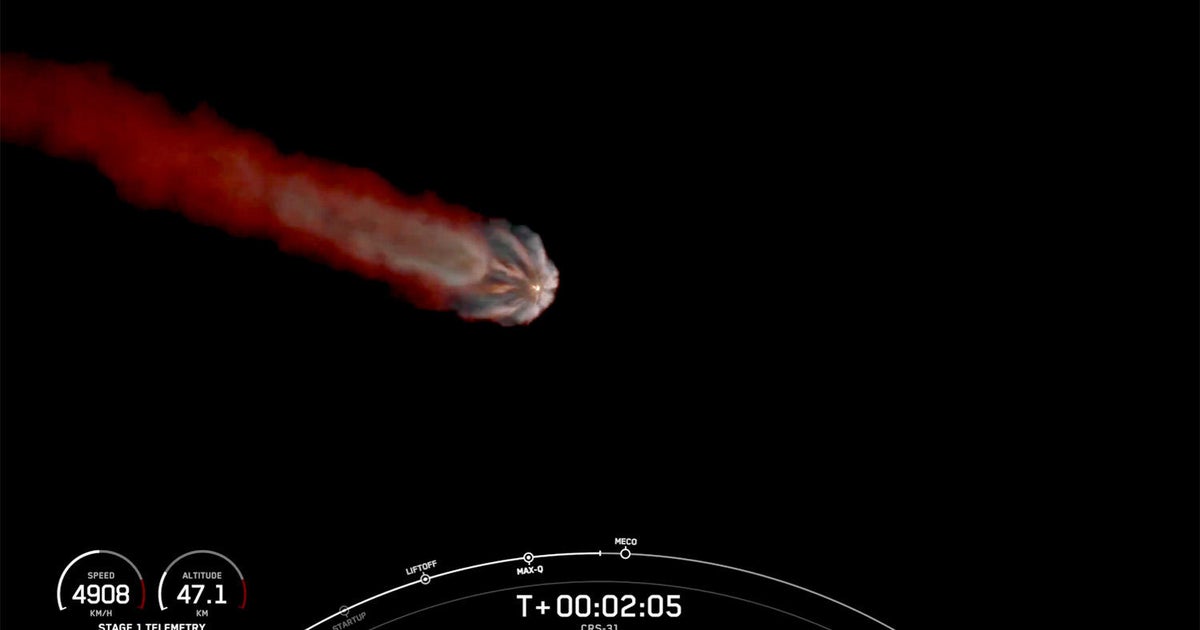CBS News
Why do total solar eclipses happen? Learn what will cause tomorrow’s celestial show.
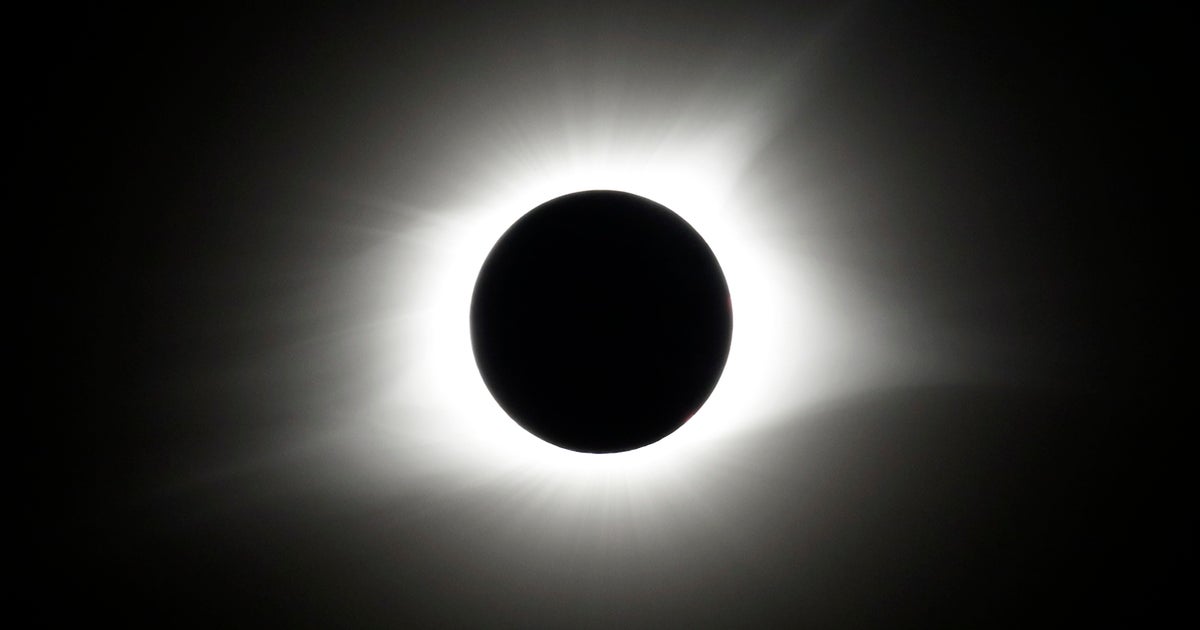
The next total solar eclipse takes shape Monday, April 8, when an overlap between the sun and the moon is expected to darken daylight skies over parts of North America and ask awestruck Earthlings to briefly reckon with their place in the universe. It will mark the United States’ first total solar eclipse since August 2017, although experts say this upcoming astral event could prove to be even more impressive than the last.
Here’s what to know about total solar eclipses and why they occur.
What exactly is a solar eclipse?
Eclipses of all types are caused by an alignment in space between the sun, moon and Earth. Their precise choreography results in one celestial body obscuring another, and, depending on whether the moon is positioned on the side of Earth nearest the sun or farthest from it, the moon either casts its shadow onto Earth or vice versa. During a lunar eclipse, like the one that appeared over much of the Western hemisphere in late March, all three align with Earth sandwiched in between. That sometimes allows people to watch as a shadow of the planet, backlit by the sun’s rays, moves across the moon’s surface.
Their alignment is switched during a solar eclipse. The moon, while orbiting Earth, passes between the planet and the sun in such a way that it appears to cross directly in front of the star, temporarily blocking its light from view. With the sun behind it, a shadow of the moon is cast onto Earth.
NASA’s Goddard Space Flight Center
People within the path of that shadow — much narrower than the shadow Earth casts onto the comparatively smaller moon during a lunar eclipse — will see day turn to twilight as the moon passes overhead along its orbit.
Mark Humphrey / AP
“It’s profound,” said Michael Kirk, a research astrophysicist at NASA’s Goddard Space Flight Center who traveled to Oregon for the total solar eclipse seven years ago. “Because it brings all of these astronomical qualities and quantities down to what you can see with your eyes.”
Why do total solar eclipses happen?
Because Earth is constantly orbiting the sun, and the moon constantly orbits Earth, an eclipse of some kind generally occurs four to seven times each year, somewhere in the world. Total eclipses are less common.
“It’s based on the distance from the Earth to the moon, the Earth’s orbit and, of course, the position of the sun in the sky from Earth,” said Kirk. “When all of those align, when that recipe gets to be just right, you get a total solar eclipse.”
They are also especially striking to witness from Earth, something scientists chalk up to a spectacular cosmic coincidence. The sun’s diameter — the length from one end to the other — is about 400 times as large as the moon’s, and its position in space is about 400 times farther than the moon’s from Earth. From the vantage point of the planet, that ratio causes the moon and sun to look as though they are similar sizes. It can make for dramatic solar eclipses, since the moon can block out all or most of the light.
Solar eclipses can only occur during a new moon, a milestone phase of the lunar cycle. New moons happen roughly once a month, when the moon’s orbit around Earth and Earth’s orbit around the sun intersect, with the moon gliding between the star and the planet. A similar intersection happens during a full moon, the new moon’s polar opposite. On that end of the cycle, Earth winds up in the middle instead.
Like the planet, the moon has its own sort of night and day, determined by which side of the moon faces the sun at different points in its orbit. As sunlight reflects off of half of the surface of the moon, people gazing upward see its bright, sun-facing side as moonlight.
None of the moon’s sunny side faces Earth during a new moon, which is why it looks like a dark disc covering the sun during a solar eclipse. But solar eclipses do not happen each month when the new moon does.
Although the moon does pass by the sun at regular intervals, the perfect lineup necessary for a solar eclipse is often missed. The moon’s orbit around Earth is tilted compared with Earth’s around the sun. So, when their orbits cross paths during a new moon, the intersection usually happens at an angle. The angle of just about five degrees is enough to throw off the alignment, so the new moon typically passes slightly above or slightly below the slice of light beamed from the sun onto Earth, rather than passing through it. The moon’s tilted orbit is also why full moons happen monthly but lunar eclipses do not.
What exactly happens during a solar eclipse?
As the new moon glides squarely between Earth and the sun, the sunlight still shining around it from behind projects a shadow over a portion of the planet. The natural course of the moon’s orbit traces a path along the surface of Earth, which is moving, too, as it continues to track its own orbit and spins on its axis at the same time. The path then becomes a traveling shadow, called the path of totality, where within its bounds the shadow is experienced on the ground as a total solar eclipse.
“By observing the eclipse shadow pass over you, you’re actually observing the moon’s orbit in human-scale real-time,” said Kirk. “When you see the eclipse shadow racing across the land as you go into totality, and you’re in it for a minute and you see it leaving just as fast, that is literally the orbit of the moon that you’re watching.”
The moon is closer to Earth now than it was during the total solar eclipse that dazzled millions of Americans in 2017, so tomorrow’s spectacle will have a much wider path of totality. That presents a unique opportunity for many across the country to witness a total solar eclipse, perhaps for the first time. In the contiguous United States, there will not be another chance for 20 years.
Monday’s eclipse will see the moon temporarily blot out the sun in skies over a vast stretch of North America, moving from the Pacific Coast of central Mexico to the southwestern U.S., the Midwest, the Northeast and New England before tapering off in far-eastern Canada. Millions of people are flocking to places inside the path of totality, which includes cities like Dallas and Buffalo, for the show.
As the eclipse passes overhead, people watching should see afternoon light fade to resemble something like dusk or dawn. But anyone who decides to look up, even through a camera lens, needs to wear specialized protective glasses.
Weather permitting, observers in the path of totality may also be able to see wisps of the sun’s outermost atmosphere, called corona. They could potentially see a coronal mass ejection, too, which is essentially an eruption of solar material from that outer layer. Unlike the total solar eclipse in 2017, this one comes in the midst of an especially active and energetic period for the sun.
What is different about the cause of a partial solar eclipse?
People just outside the path of totality tomorrow may witness a partial solar eclipse, which happens when the moon passes between the sun and the planet without flawless alignment. Skywatchers inside the path will likely see partial eclipses before and after totality. From Earth, the moon appears to cover only part of the sun during a partial solar eclipse, at times creating the crescent shape more often associated with moonlight.
Altaf Qadri / AP
Partial and total are not the only categories of eclipse. Annular is another iteration, where the cosmic recipe for a total solar eclipse unfolds but the moon is at, or close to, the farthest point from Earth in its elliptical orbit. As it did with the annular eclipse that slipped past the U.S. last October, that extra distance causes the moon to appear smaller against the backdrop of the sun during an eclipse, like a black spot surrounded by a fiery ring. Eclipses can also shift in some situations between an annular presentation and totality.
What determines the timing of a solar eclipse?
Tomorrow’s solar eclipse starts over the South Pacific Ocean, according to NASA, and the phenomenon is first expected to arrive on land in coastal Mexico at around 11:07 a.m. PDT. Totality will linger longest near the beginning of the eclipse’s path, over an area about 25 minutes northwest of the city of Torreón. There, for up to 4 minutes and 28 seconds, the sun will all but disappear behind the dark veil of the moon.
Earth’s rotation guides the path and timing of an eclipse as much as the moon’s orbit. Whichever spot on the planet’s surface finds itself exactly aligned with the moon when the moon aligns with the sun is where the eclipse “begins.” In this case, that spot is somewhere in the South Pacific. But the moon’s position changes in orbit while the planet turns as the day goes on, and their calibration with the sun eventually falls out of alignment. The eclipse “ends” at the spot on Earth’s surface where alignment is intact for the last time.
NASA’s Scientific Visualization Studio
How long totality lasts in any given place is based on the curvature of the Earth, and the distance between its surface and the moon during a solar eclipse.
“The peak eclipse is where the moon is closest to the Earth’s surface and the most aligned with the sun,” said Kirk. “So, as that alignment gets off from the ideal peak, and you move around on the Earth’s surface because the Earth is round, that curvature brings you out of perfect alignment just a little bit. That means the length of time that you get that perfect alignment between the Earth, sun and moon to get totality is just a little bit shorter, and a little bit shorter.”
After tomorrow’s eclipse leaves Mexico, totality will touch parts of Texas, Oklahoma, Arkansas, Missouri, Illinois, Kentucky, Indiana, Ohio, Pennsylvania, New York, Vermont, New Hampshire and Maine, as well as limited areas in Tennessee and Michigan along the way. Once the eclipse passes through the U.S., it is forecast to enter Canada in Southern Ontario before moving on to Quebec, New Brunswick, Prince Edward Island and, finally, Cape Breton. It will exit continental North America on Newfoundland’s Atlantic Coast at 5:16 p.m. in the local time zone.
NASA/Scientific Visualization Studio/Michala Garrison; eclipse calculations by Ernie Wright, NASA Goddard Space Flight Center
The amount of time spent in darkness at each location within the path of totality is shorter than the last. But areas all along the eclipse’s route will still experience it for long enough to notice, with scientists estimating that even portions of Canada at the far end of it will witness totality for up to 3 minutes and 21 seconds.
For comparison, the longest period of totality observed during the 2017 solar eclipse was only 2 minutes and 42 seconds, near Carbondale, Illinois. Plus, NASA has estimated that 99% of people in the U.S. will experience the next solar eclipse to some degree — either partially or totally — no matter where they live. That includes parts of Alaska and Hawaii.
CBS News
U.S. Marines, Japanese and Australian troops will train together amid heightened concerns over China
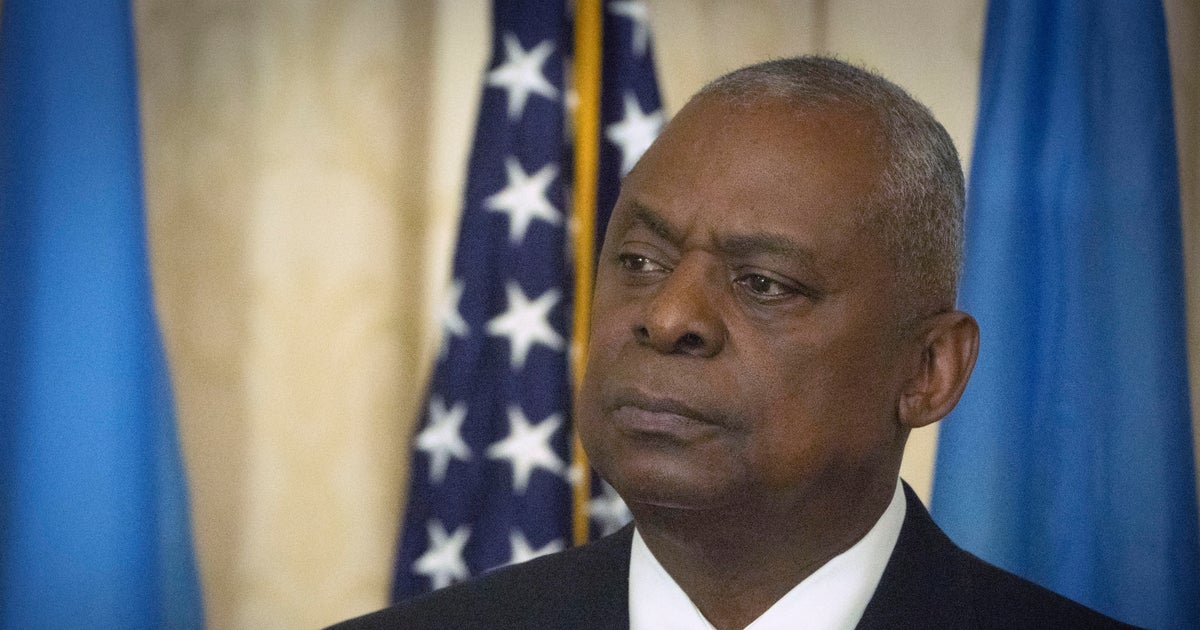
U.S. Marines will take part in joint training with Japanese and Australian forces in northern Australia, the three countries’ defense ministers announced Sunday as they expressed concern about a spate of confrontations with China’s increasingly assertive military.
Australia’s acting Prime Minister Richard Marles hosted U.S. Defense Secretary Lloyd Austin and Japanese Defense Minister Nakatani Gen for talks in Darwin, Australia.
The trilateral amphibious training between Australia, Japan and the U.S. Marine rotational force in northern Australia will begin in 2025 with Exercise Talisman Sabre. Australia will also join Exercise Orient Shield in Japan for the first time next year.
“Recognizing the critical role the trilateral partnership plays to uphold regional stability, we commit to trilateral policy coordination and to consult each other on regional security issues and contingencies,” they said in a joint statement.
In their statement, the three defense ministers reiterated “serious concern” about destabilizing actions in the East and South China seas including “dangerous conduct” by the Chinese military against Philippine and other vessels from the region. China claims the South China Sea almost in its entirety.
“We reiterate our strong opposition to any unilateral attempts to change the status quo by force or coercion,” they said, adding that it is “important that all states are free to exercise rights and freedoms consistent with international law.”
The ministers also urged the importance of peace and stability across the Taiwan Strait. China claims self-ruled Taiwan as its own territory and has stepped up military harassment with frequent drills around the island.
Marles, who is also Australia’s defense minister, said following talks with his Japanese counterpart in September that both nations looked to ways to build greater familiarity between their forces. One of the “obvious opportunities” was for Japan to participate in activities during the U.S. Marine rotation in Australia, he said Sunday.
“Having a more forward-leaning opportunity for greater training with Japan and the U.S. together is a really fantastic opportunity,” he said.
Asked if the increased military cooperation would anger Beijing, Marles said the decision was about building “the best relationships possible with like-minded countries, with our friends and with our allies.”
CBS News
Photographing the rooms of kids killed in school shootings

An unmade bed
A library book 12 years overdue
The next day’s outfit
Notes to her future self

Click on the door to enter
CBS News
How do you make a portrait of a child who isn’t there? Photographer Lou Bopp found a way, but it wasn’t easy.

In early 2018, I was deplaning after an 18-hour flight when Steve Hartman called. He had an idea: to photograph the still-intact bedrooms of kids who had been killed in school shootings.
It’s a headful. And six years later, I still don’t have an “elevator pitch” for the project — but then, I don’t often talk about this project. It is by far the most difficult I have ever worked on.
When Steve, my friend of about 25 years, asked me if I would like to be involved, I said yes without hesitation — even though I didn’t think we would get any families to agree. There is no way that I would have said no to partnering with him on this.
Emotionally, I was not sure how I would get through it. Within a few months I was on my way to Parkland, Florida. Alone. I’m not sure that I realized that I would be on my own.
But here I was. An on-location commercial photographer who focuses on people and pets to create compelling, honest, textural and connective moments for large brands, per my LinkedIn professional profile, on a project where there is no one to take photos of — for the most brutal of reasons.
How do you make a portrait of a child who is not there?
In each of these children’s rooms — the most sacred of places for these families — there was the sense that the child had just been there, and was coming right back. It was as if they’d just left their room like that when they went to school in the morning and were returning in the afternoon.
I wanted to capture that essence.
Most kids’ bedrooms are their very own special places, and these were no different. I looked everywhere, without touching anything. I photographed inside trash cans, under beds, behind desks. Their personalities shone through in the smallest of details — hair ties on a doorknob, a toothpaste tube left uncapped, a ripped ticket for a school event — allowing me to uncover glimpses as to who they were.
But there was an emotional challenge in addition to that creative one. Over the course of more than six years, we visited with many families around the country. The parents I spoke with seemed grateful that I was there. But each time I received a call or text from Steve about a new family, my heart sank.
It meant another family had lost a child.
I find it unfathomable that children being killed at school is even an issue. It makes no sense. It’s impossible to process. The night prior to each one of the family visits, I didn’t sleep. And I knew I wouldn’t going into the project. It’s not a self-fulfilling prophecy. It is nerves. And empathy. And sorrow. And fear.
In my notes from early on in the project, back in 2018, writing in seat 6H on the flight back from Nairobi, I reflected on the emotional task ahead.
“This is going to be one of the most difficult things ever, emotionally, for me, and not just work related. As I read my research documents, I get visibly emotional,” I wrote, noting my gratitude that the dark cabin prevented the other passengers from seeing me.
The prospect brought my own fears to the fore, both for myself — “I can’t help thinking about Rose,” my daughter, “and what if. I’ve lost sleep over envisioning the what-ifs well before Parkland” — and about and for meeting the families in the project: “When I read about April & Phillip and Lori’s plight, I somehow, for some reason put myself in their emotional position even though that is impossible, I have no idea, it’s beyond comprehension, I do not know what they feel. I do not know what I am going to say to them, I’m scared beyond belief. And alone.”
But just days later, I was photographing the first assignment for the project: Alyssa Alhadeff’s room. She was just 14 years old when she walked out of that room to head to Marjory Stoneman Douglas High School. I was shaky meeting the family friend who greeted me at the house. Her daughter was Alyssa’s best friend, and a photo of the two girls was on the table.
According to my notes, “The room was a beautiful teenager’s messy room. My emotions were kept in check the way that they usually are; By hiding behind the camera. I removed my shoes before entering. My heart was pounding and it reverberated through my body and soul, I felt like I was in one of the most sacred and special places on Earth. I was so careful not to touch anything.”
I left feeling ready to explode in sadness and anger.
Later that day, I photographed Carmen Schentrup’s room. Her younger sister had survived the Parkland shooting, but 16-year-old Carmen was killed in her AP Psychology class. Meeting her parents, April and Phillip, was what I was most scared of.
“I feel so much pain and compassion for them and I don’t want to say the wrong thing, drop cliches etc.,” I wrote at the time. “I spoke to Steve for guidance. He said, just be you. That’s all I can do. Just be me. He was right, those three words helped carry me through this entire project. Just be me.”
April let me in, and I worked quickly, only meeting Phillip as I was leaving. “The conversation felt like we all three were just trying to hold it together. I cannot imagine what they are going through, my heart hurts for them. This was / is such a painful project, and reconciling it will be impossible.
“I think about how anything can happen at any time to any of us. Literally. You never know,” I wrote.
After only about 16 hours on the ground in Florida, I was done with the first portion. I felt the project was a must, but I also dreaded the next call from Steve about the next family. I didn’t know when that call would come — many years later, or the very next day, possibly never.
But last month, we — and the documentary crew that filmed us working — completed this project. While I haven’t seen it yet, I know Steve’s piece won’t be a typical Steve Hartman segment. How could it be? I know he struggled too, and we both have spent a lot of time processing this.
I remember one August evening, I was devastated as I left the home of one of the families. Within minutes, I passed an ice cream shop crowded with other families — seemingly carefree, full of joy and laughter. The juxtaposition, mere minutes apart, cracked my soul.
I hope some way, somehow, this project can facilitate change — the only possible positive outcome for this I could comprehend. After the news cycle ends, these families will still be living with an incomprehensible nightmare.


